|
Henna and Saccharides Catherine Cartwright-Jones and Kate Capek © 2004 Saccharides are hydrocarbons, frequently containing the group C6H10O5. Plants make monosaccharides, disaccharides and polysaccharides. Monosaccharides are the smallest molecules in this group, a single aldehyde or ketone functional group. Disaccharides are a condensed pair of monosaccharides, and polysaccharides are a chain or cluster of monosaccharides joined by glycosidic bonds. Saccharides are some of the gooey, stringy things henna artists add to henna pastes to improve the texture so they can make more intricate patterns. When henna artists add tamarind, okra, or yogurt to their henna paste, they are adding polysaccharides. When artists add sugar or jaggery, they add disaccharides. Both of those saccharides improve henna paste consistency. Honey has some monosaccharides, and is used by henna artists to improve paste consistency, but a pure form of monosaccharides is not naturally available to henna artists. Henna itself often produces high levels of polysaccharides when it has been under heat and drought stress. This henna is characteristically stringy. Paste made from henna with higher levels of polysaccharides tends to be gooey and stringy like bread dough. This paste cracks very little during drying, and clings to the skin so little or no seal is necessary. You can drape long, smooth, parallel lines with stringy henna. Paste made from henna with lower levels of polysaccharides tends to be pasty or grainy like mashed potatoes. That paste cracks during drying, and has to be carefully sealed to not fall off the skin. You cannot drape lines easily with pasty henna, because the paste thread breaks easily. If you have a pasty henna, and want to it to drape easily, crack less, and adhere to the skin better, add saccharides to the paste! Refined sources of saccharides work just as well as the traditional sources, and are a little easier to manage. Any saccharide is going to change your paste texture. Monosaccharides, disaccharides, and polysaccharides all change henna paste texture, each affects it in a slightly different way. Try stuff! See what works for you! 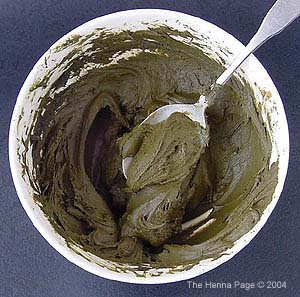 I mixed up a batch of henna paste
from a pasty henna powder, one which always cracks and falls off
skin as it dries.
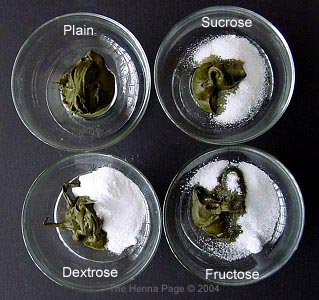 I divided the paste into 4
samples: One sample was left plain, and added a saccharide to each of
the other 3 samples.
Each had 3 parts paste to 1 part saccharide. I used fructose (a monosaccharide), dextrose (a monosaccharide), and table sugar (sucrose, a disaccharide), . 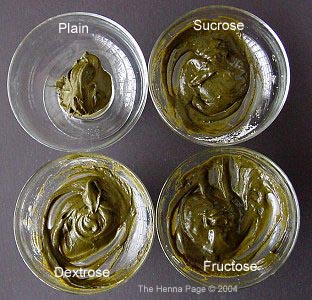 When I stirred in the saccharides,
the pastes immediately changed consistency.
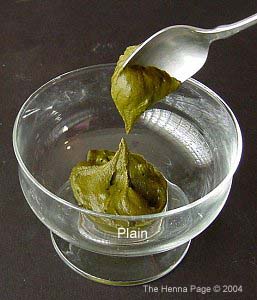 The picture above is the plain
henna paste without sugar. When I lifted the spoon, the plain
paste stayed on the spoon. I could not pull out a long strand of
paste before it broke
off.
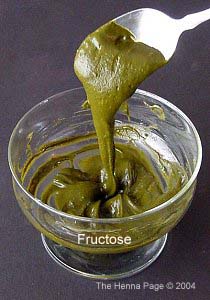 The picture above is henna paste with fructose. Fructose is a monsaccharide. When I lifted the spoon out of the fructose paste, I could pull a long strand easily and the paste cascaded off quickly, like honey. 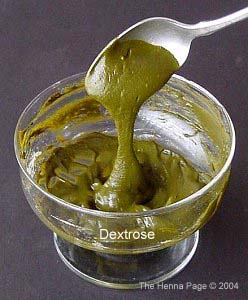 The picture above is henna paste with dextrose, a monosaccharide. When I lifted the spoon out of the dextrose paste, I could pull a long strand easily, and the paste cascaded off quickly, like honey. 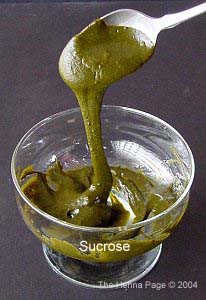 The picture above is henna paste
with table sugar, sucrose, a disaccharide. When I
lifted the spoon out of the sucrose paste, I could pull a
long strand easily and the paste cascaded
off quickly, like honey.
|
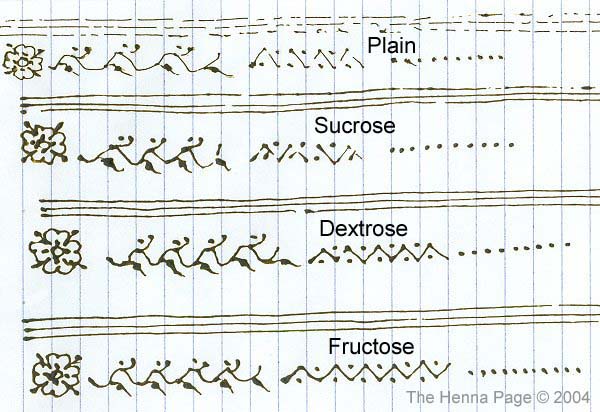
| Results: Plain henna paste: I had to use considerable thumb pressure on the cone. The plain henna paste did not drape easily, lines b broke frequently. The lines averaged over 10 breaks in 8". Dots and complex figures were prone to error because of difficult paste consistency. As the paste dried, the lines cracked open further and flaked off the paper. Henna paste with fructose: a monosaccharide: Henna paste flowed from the cone with very little thumb pressure. The fructose henna paste easily draped long straight lines. The lines averaged 1 break in 8". Dots and complex figures were easy to control. When the paste dried, the henna paste held firm to the paper. The texture was stringy but easy to handle. Henna paste with dextrose, a monosaccharide: Henna paste flowed from the cone with very little thumb pressure. The dextrose henna paste easily draped long straight lines. The line averaged 1 break in 10". Dots and complex figures were easy to control. When the paste dried, the henna paste held firm to the paper. The texture was silky and easy to handle. Henna paste with sucrose, a disaccharide: Henna paste flowed from the cone with very little thumb pressure. The sucrose henna paste draped straight lines. The lines averaged 1 break in 4". Dots and complex figures were often messed up with skips and blobs. When the paste dried, the henna paste held firm to the paper. The texture was stringy, but apt to catch on the cone tip, causing blobs and skips. Conclusions: Both monosaccharides and disaccharides change grainy henna paste into silky, stringy henna paste. Henna paste mixed with monosaccharides (fructose and dextrose) drape longer lines without breaking than henna paste mixed with a disaccharide (succhrose). Henna paste mixed with saccharides sticks to the skin better, and cracks less when drying. In further tests, 3 - 5 parts henna paste to 1 part saccharide seemed to be a good range for paste mixes. Learn more about Monosaccharides Learn more about Disaccharides Learn more about Polysaccharides |
| Can't find
what you're looking for?
Try: The Henna Page Main Index http://www.hennapage.com/henna/mainindex.html *"Henna,
the
Joyous Body Art"
the Encyclopedia of Henna Catherine Cartwright-Jones c 2000 registered with the US Library of Congress TXu 952-968 |